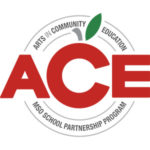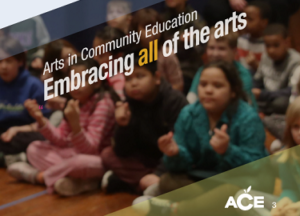
ACE FAQs
Questions about Arts in Community Education answered
- Do I have to have a music or arts specialist in my building to participate?
- What grade levels participate in the ACE program?
- Is there an ACE curriculum?
- What art forms does ACE use?
- Is ACE compatible with school models currently in use?
- What are the benefits of ACE for students?
- What are the benefits of ACE for teachers?
- Who is responsible for managing the ACE program in our building?
- How often do ACE ensembles visit my school?
- What does ACE cost, and what is included?
- How do schools pay for ACE?
- How does Virtual ACE work? Who can participate?
Do I have to have a music or arts specialist in my building to participate?
No. While ACE will work closely with a school specialist, it is not a requirement.
What grade levels participate in the ACE program?
The classic ACE program begins in K5 and adds a grade level each successive year until fully integrated at 5th grade. Schools may choose to integrate more quickly. A middle school component, which works like a mini artist-in-residency, is also available.
Is there an ACE curriculum?
ACE aims to support teachers in integrating the arts into their own curriculum. Multiple resources are available to assist teachers with the process.
What art forms does ACE use?
While it is a program of the Milwaukee Symphony, ACE embraces all the arts: dance and movement, drama, visual arts, spoken word, and all genres of music. Our ACE ensembles are made up of both MSO musicians and Cultural Partners including the Milwaukee Ballet, Ko-Thi African Dance Company, Skylight Music Theatre, and many more. You get access to the best arts organizations from Southeastern Wisconsin (and beyond) all in one program.
Is ACE compatible with school models currently in use?
Yes, ACE complements IB, EL, STEM, Montessori and other school models.
What are the benefits of ACE for students?
Much research has been done on the positive impact of the arts on student learning and development. ACE fosters an environment for enhanced student learning through arts integration, and inspires excellence and creativity through high quality, novel arts experiences. ACE also supports whole child development, broadens perspectives, and encourages appreciation of diverse cultures.
What are the benefits of ACE for teachers?
ACE supports teachers in becoming more effective and creative educators. Many teachers also use ACE to assist them in fulfilling their Educator Effectiveness requirements and documentation, including SLOs and PPGs.
Who is responsible for managing the ACE program in our building?
Each school names an ACE Contact who becomes the point person with the MSO. Our MSO ACE staff are in close communication with the ACE Contact to schedule ACE visits (based on your school’s unique schedule), collect needed information, and manage and support the partnership.
How often do ACE ensembles visit my school?
Each grade level in the program receives three ACE ensemble visits per year (K5 gets four). These visits are spread throughout the school year. Each visit lasts approximately 30-45 minutes.
What does ACE cost, and what is included?
ACE fees are based on school size and the number of students participating in the program. ACE fees are all-inclusive. The only non-covered cost is bus transportation to the MSO ACE concerts. For a full explanation of the ACE fee structure, please click here.
How do schools pay for ACE?
Some schools include ACE in their budgets, some add it to student fees, and others do specific fundraising for the program. At some schools, PTOs pay all or part of the program.
How does Virtual ACE work? Who can participate?
In Virtual ACE grade level specific video presentations replace the in-person artist visits. Teachers have access to digital and online resources and virtual PD opportunities. Participating schools and homeschools will have access to the ACE concerts digitally.
The Virtual ACE Program is available to schools too far from Milwaukee to be served by the in-person program, homeschools, and schools that cannot participate in the in-person program due to safety concerns or other significant barriers. For more information, please contact us at edu@mso.org or 414-226-7812.

Interested in learning more about the Arts in Community Education program?
Click the button below to fill out the ACE interest form.
Get StartedVolunteer
Interested in becoming more involved in education events? Find out more about volunteer opportunities with the Milwaukee Symphony.
Get StartedDonate Now - Education
Help support the Milwaukee Symphony Orchestra’s education programs and initiatives. Select MSO Education as your type of gift when submitting a donation.
Donate Now
